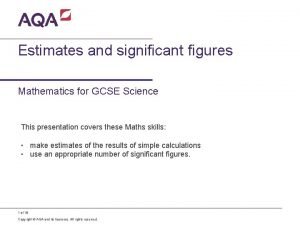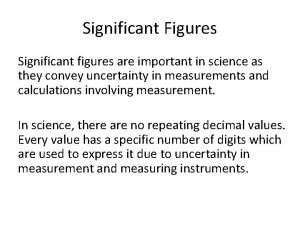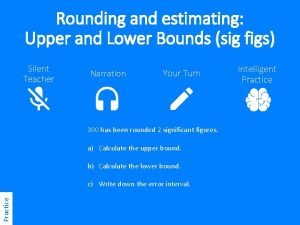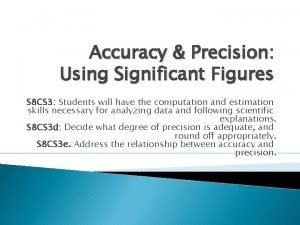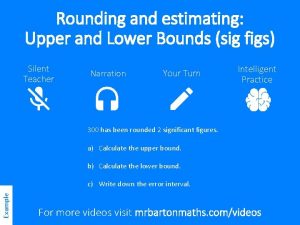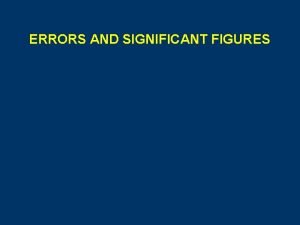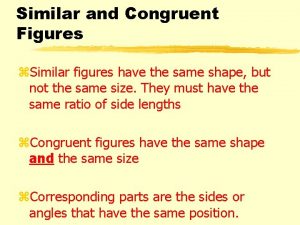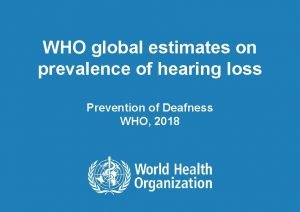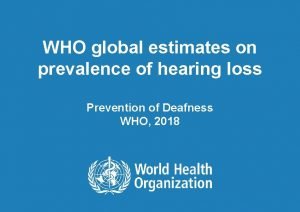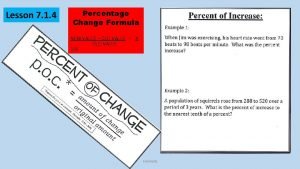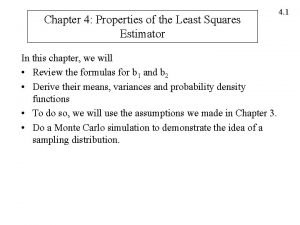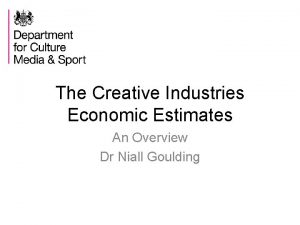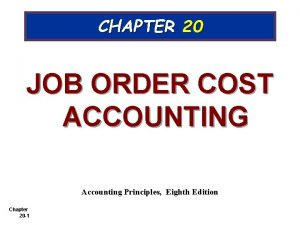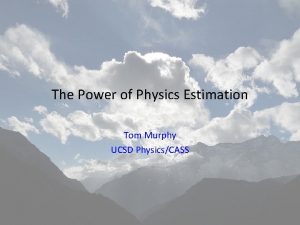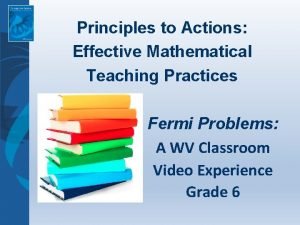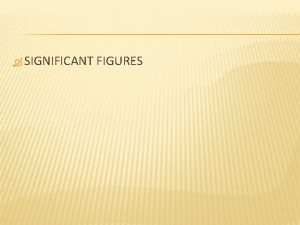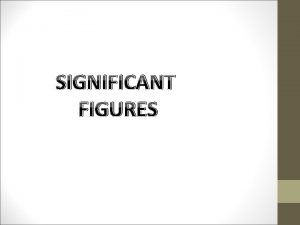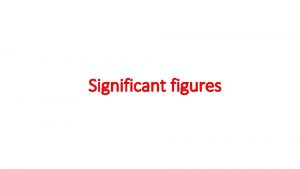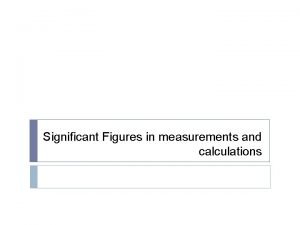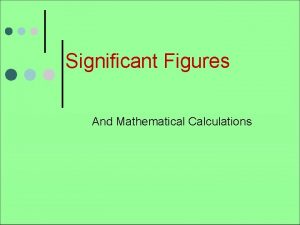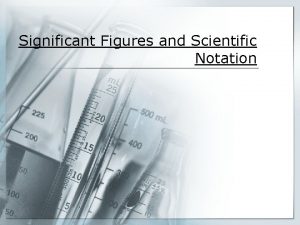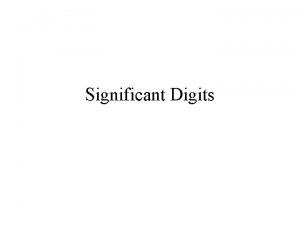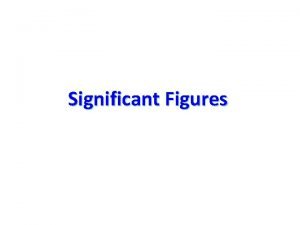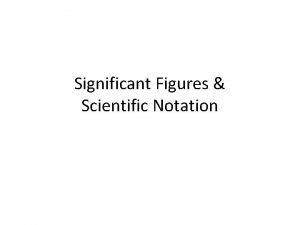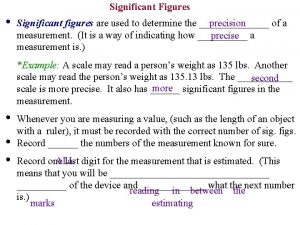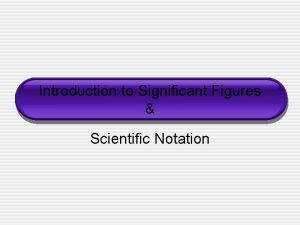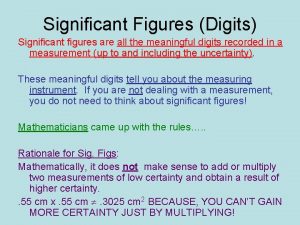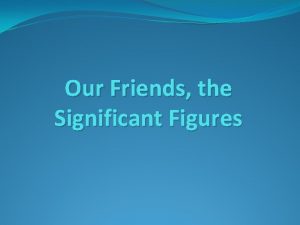Estimates and significant figures Mathematics for GCSE Science


















- Slides: 18

Estimates and significant figures Mathematics for GCSE Science This presentation covers these Maths skills: • make estimates of the results of simple calculations • use an appropriate number of significant figures. 1 of 18 Copyright © AQA and its licensors. All rights reserved.

Why do we round? Any suggestions? • To avoid writing irrelevant figures. • For simplicity, when greater precision is not necessary, e. g. for large numbers such as populations. • To make large or complicated calculations easier (usually when calculators are not available). Rounding and estimating are two ways to make numbers easier to manage. Rounding is a useful tool in estimation of large or difficult problems, and plays a part in finding significant figures. 2 of 18 Copyright © AQA and its licensors. All rights reserved.

What are the rules? You use a number line to see which end is nearer. 38 rounds to 40 to the nearest 10 as it is nearer 40 than 30. 3. 13 rounds to 3. 1, to 1 decimal place, as it is nearer 3. 1 than 3. 2. 3. 15 rounds to 3. 2, to 1 decimal place, because we have a convention that says round up for the halfway point. That way everybody does the same thing. 3 of 18 Copyright © AQA and its licensors. All rights reserved.

What is a significant figure? A number’s significant figures are the ones that affect the size of the number most – the significant ones in terms of its size! • Non-zero digits are ALWAYS significant • Zeroes BETWEEN non-zero digits are significant. • Leading zeroes are NEVER significant. • Zeroes TO THE RIGHT of the last non-zero digit can be significant. • We will be applying these rules in the following slides, so make a note… 4 of 18 Copyright © AQA and its licensors. All rights reserved.

Identifying significant figures Can you number the significant figures? 3. 28034 1 st 2 nd 3 rd 4 th 5 th 6 th What about this one? 0. 00760 1 st 2 nd 3 rd 5 of 18 Copyright © AQA and its licensors. All rights reserved.

Rounding in practice Round 2. 837076 to 3 s. f. Number the significant figures 1 st 2 nd 3 rd 4 th 5 th 6 th 7 th 2. 837076 There are two options: 2. 83 REMEMBER: Imagine 2. 837076 on a number line It lies between 2. 83 and 2. 84 We need to look at the following figure – that tells us which end the number is nearer. it is nearer 2. 84, so we choose the right-hand end 2. 837076 to 3 s. f. is 2. 84 6 of 18 Copyright © AQA and its licensors. All rights reserved.

Rounding in practice Round 0. 03601 to 3 s. f. Number the significant figures… 1 st 2 nd 3 rd 4 th 0. 03601 There are two options: 0. 0360 REMEMBER: Imagine 0. 03601 on a number line It lies between 0. 0360 and 0. 0361. It is nearer 0. 0360, so we choose that 0. 03601 to 3 s. f. is 0. 0360 7 of 18 Copyright © AQA and its licensors. All rights reserved. 0. 0361 We need to look at the following figure – that tells us which end the number is nearer.

Rounding in practice Round 0. 009909 to 3 s. f. Number the significant figures… 1 st 2 nd 3 rd 4 th 0. 009909 There are two options: 0. 00990 REMEMBER: Imagine 0. 009909 on a number line It lies between 0. 00990 and 0. 00991 It is nearer 0. 00991, so we choose that 0. 009909 to 3 s. f. is 0. 00991 8 of 18 Copyright © AQA and its licensors. All rights reserved. 0. 00991 We need to look at the following figure– that tells us which end the number is nearer.

Why do we estimate? • • • We estimate to generate an answer, precise enough to be useful. It is not the same as guessing! In a field full of sheep which are fairly evenly distributed… They are moving, and impossible to count! We can count the number in a small area, and scale it up. 9 of 18 Copyright © AQA and its licensors. All rights reserved.

Estimation • 10 of 18 Copyright © AQA and its licensors. All rights reserved.

Estimation in practice 11 of 18 Copyright © AQA and its licensors. All rights reserved.

Application of estimation and significant figures • 12 of 18 Copyright © AQA and its licensors. All rights reserved.

Some questions to try from Exampro GCSE Maths F 13 of 18 Copyright © AQA and its licensors. All rights reserved.

GCSE Maths F 14 of 18 Copyright © AQA and its licensors. All rights reserved.

GCSE Maths F 15 of 18 Copyright © AQA and its licensors. All rights reserved.

GCSE Chemistry sample assessment materials 16 of 18 Copyright © AQA and its licensors. All rights reserved.

GCSE Physics sample assessment materials 17 of 18 Copyright © AQA and its licensors. All rights reserved.

GCSE Physics sample assessment materials 18 of 18 Copyright © AQA and its licensors. All rights reserved.
 Significant figures gcse
Significant figures gcse Why are significant figures important in science
Why are significant figures important in science Upper and lower bounds to 3 significant figures
Upper and lower bounds to 3 significant figures Upper and lower bounds significant figures
Upper and lower bounds significant figures Accuracy, precision, and significant figures worksheet
Accuracy, precision, and significant figures worksheet 3 significant figures upper and lower bounds
3 significant figures upper and lower bounds Errors and significant figures
Errors and significant figures Similar and congruent shapes
Similar and congruent shapes Flat shape with eight sides
Flat shape with eight sides Pentagon plane figure or solid figure
Pentagon plane figure or solid figure Who global estimates on prevalence of hearing loss 2020
Who global estimates on prevalence of hearing loss 2020 Who global estimates on prevalence of hearing loss 2020
Who global estimates on prevalence of hearing loss 2020 Eva estimates that 475 songs
Eva estimates that 475 songs Gauss markov assumptions
Gauss markov assumptions Creative industries economic estimates
Creative industries economic estimates Building maintenance cost estimates
Building maintenance cost estimates Job order costing
Job order costing Fermi problem
Fermi problem Fermi problem
Fermi problem
